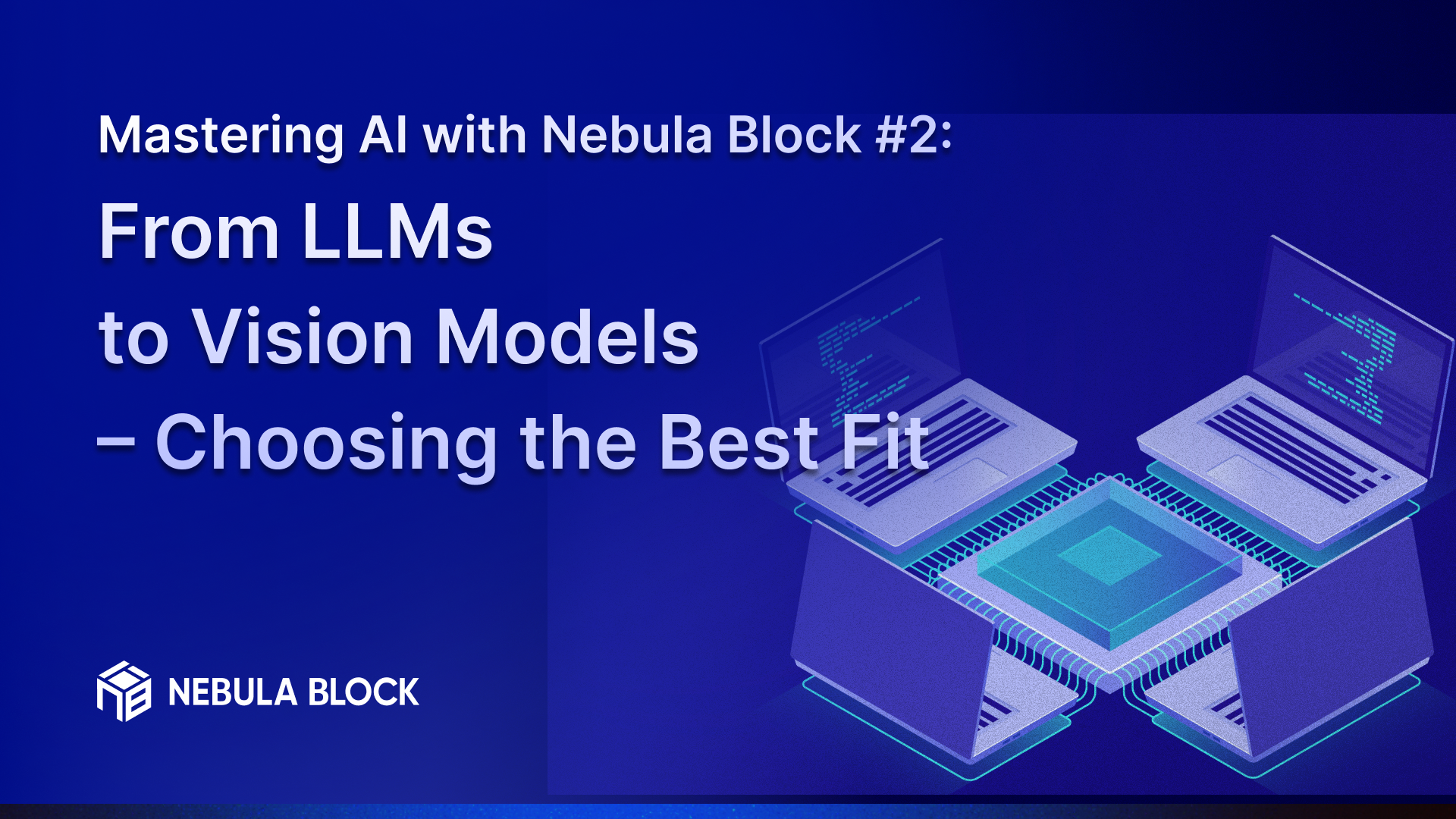Mastering AI with Nebula Block #2: From LLMs to Vision Models – Choosing the Best Fit

Choosing the right AI model is crucial to your project’s success. With a myriad of available AI models, each designed to tackle specific tasks and challenges, it’s essential to understand which one aligns best with your particular needs.
In this blog, we’ll explore the various AI models and provide guidance on selecting the most suitable model for your applications.
Why Choosing the Right Model Matters
Picking the wrong model can lead to:
- Wasted GPU cycles and higher costs
- Poor accuracy and subpar user experience
- Longer development cycles
On the other hand, the right model:
- Improves performance and results
- Reduces infrastructure expenses
- Speeds up time-to-market
Key factors to consider:
- Task alignment: Is your challenge text, vision, multimodal, or domain-specific?
- Compute requirements: Some models need H100s or B200s, while others run fine on RTX 4090s.
- Latency vs. accuracy: A customer-facing chatbot needs speed; scientific research may prioritize precision.
- Scalability: Can it handle production-level load beyond prototyping?
Understanding Practical AI Models
AI models can be broadly categorized based on their architectures and intended applications. Here are some common types:
1. Language Models
- Description: These models are designed for natural language processing (NLP) tasks, such as text generation, translation, summarization, and sentiment analysis.
- Examples:
- GPT (Generative Pre-trained Transformer): Excellent for text generation and conversational agents.
- DeepSeek V3: state-of-the-art large language model for reasoning and generation.
2. Vision Models
- Description: Focused on image processing tasks, vision models can handle tasks like object detection, image classification, and visual question answering.
- Examples:
- Qwen2.5-VL-7B-Instruct: strong at image-text reasoning and visual question answering.
- DeepSeek-VL: versatile vision-language model for multimodal search and captioning.
3. Multimodal Models
- Description: These models can process and generate outputs for multiple types of data, such as text, images, and audio.
- Examples:
- Claude-Sonnet-4: supports multimodal reasoning across text and vision.
- GPT-4o-mini: optimized multimodal model for fast and efficient inference.
4. Reinforcement Learning Models
- Description: These models apply reinforcement learning principles for decision-making tasks, where an agent learns to make choices based on rewards.
- Examples:
- Deep Q-Networks (DQN): Used in gaming environments where agents learn to make decisions through trial and error.
5. Generative Models
- Description: Focused on generating new data points similar to the training set, these models excel in creative tasks.
- Examples:
- Bytedance-seedream-3.0: advanced text-to-image generation with high-quality results.
- FLUX.1: efficient diffusion model for fast and high-fidelity image synthesis.
Comparison of Performance and Use Cases
When selecting an AI model, it’s essential to compare their performance characteristics and suitable use cases. Here’s a quick comparison of the models mentioned:
| Model Type | Strengths | Typical Use Cases | Examples |
|---|---|---|---|
| Language Models | Strong in natural language understanding and generation | Chatbots, content creation, summarization, coding assistants | DeepSeek V3, NuMarkDown-8B-Thinking, LLaMA, GPT |
| Vision Models | Specialized in image and video analysis | Image classification, object detection, medical imaging | Qwen2.5-VL-7B-Instruct, DeepSeek-VL |
| Multimodal Models | Process multiple modalities (text, images, audio) for richer reasoning | Visual Q&A, AI assistants, media search, multimodal interaction | Claude-Sonnet-4, GPT-4o-mini |
| Reinforcement Learning Models | Learn by trial and error, optimized for sequential decision-making | Robotics, game AI, real-time strategy, recommendation tuning | DQN, PPO |
| Generative Models | Create new content (text, images, video, audio) from training data | Art generation, synthetic data, entertainment, design | Bytedance-seedream-3.0, FLUX.1 |
This comparison shows how each model shines in different contexts, helping you align your choice with both technical and business goals.
How Nebula Block Helps You Decide
Nebula Block, Canada’s first sovereign AI cloud, makes choosing and running models easier with:
- Performance Benchmarks: Compare models on speed, accuracy, and cost.
- Free Inference Endpoints: Experiment instantly with DeepSeek V3, DeepSeek R1, and more.
- Flexible GPU Options: From enterprise B200/H200/H100 to cost-efficient RTX 5090/4090.
- Cost Transparency: Pay-as-you-go billing for predictable expenses.
- Scalability: Seamless transition from testing to production.
- Compliance: Built for Canadian data sovereignty.
- Community & Docs: Guides and shared insights to help you make informed decisions.
By combining GPU power with Nebula Block’s performance benchmarks, free endpoints, and compliance features, you can confidently select and deploy the AI models that best match your project goals.
Conclusion
Choosing the right model is as important as having access to the right GPUs. Whether you need a versatile LLM, a powerful multimodal system, or a specialized domain model, the key is matching performance, cost, and use case.
Nebula Block makes this process straightforward — giving you the infrastructure, flexibility, and sovereignty to master AI on your own terms.
👉 Stay tuned for the next article in the Mastering AI with Nebula Block series, where we'll dive into ethical and responsible AI.
What’s Next?
Sign up and explore now.
🔍 Learn more: Visit our blog and documents for more insights or schedule a demo to optimize your search solutions.
📬 Get in touch: Join our Discord community for help or Contact Us.
Stay Connected
💻 Website: nebulablock.com
📖 Docs: docs.nebulablock.com
🐦 Twitter: @nebulablockdata
🐙 GitHub: Nebula-Block-Data
🎮 Discord: Join our Discord
✍️ Blog: Read our Blog
📚 Medium: Follow on Medium
🔗 LinkedIn: Connect on LinkedIn
▶️ YouTube: Subscribe on YouTube